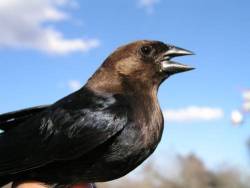Wildlife: Cowbirds Gaining Ground
Friday, November 2nd, 2012
Brown-headed Cowbird
This is Passport to Texas Supported by the Wildlife and Sport Fish Restoration Program
Calling a brown-headed cowbird a cowbird, is a misnomer as far as biologist Marsha May is concerned.
I think they should be called bison birds, and not cowbirds, because they evolved with the bison.
Semantics aside, the bird’s habit of laying its eggs in other birds’ nests can cause the decline of species with small populations, such as the endangered Black-capped Vireo. Additional species are also affected.
Woodland species are now being impacted by brown-headed cowbirds, because we’ve fragmented the woods. Previously those woodland species were protected by the woods. Now that it’s fragmented, the cowbirds are getting into that habitat, and they’re parasitizing birds that have never historically been parasitized before.
The cowbird is in the blackbird family. The male has a black body and brown head, while the female is mottled brown and gray. Want to intervene on songbirds’ behalf.
You can actually become certified in Texas to trap for cowbirds, and that’s mainly during the breeding season, between March first and May thirty-first. And, mainly you’re trying to trap the females.
Get ready for spring. Find certification information on the Texas Parks and Wildlife website.
That’s our show… the Wildlife and Sport Fish Restoration Program supports our series and is funded by your purchase of shooting and hunting equipment and motorboat fuel.
For Texas Parks and Wildlife…I’m Cecilia Nasti.



 Passport to Texas is a
Passport to Texas is a  Passport to Texas is made available by:
Passport to Texas is made available by: